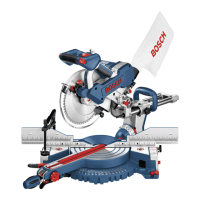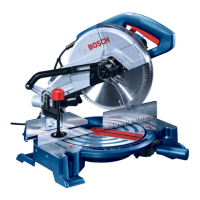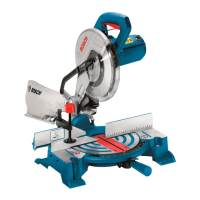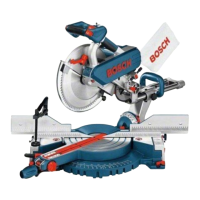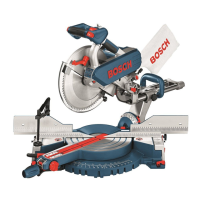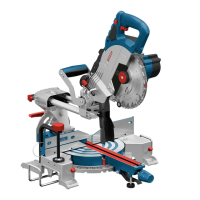English–101 609 929 F69 • (04.10) PS
Mounting the Saw Blade
Ensure that any spacers and spindle rings used are
suitable for the purpose as stated by the manufactur#
er.
When fitted with laser, the mounting of the saw blade
must be performed only by an authorised agent or the
manufacturer.
If necessary, clean all parts to be mounted.
Place the new saw blade on the tool spindle 53.
(see Figure
)
Take care during the mounting that the
cutting direction of the teeth (direction of
the arrow on the saw blade) agrees with
the direction of the arrow on the swinging
guard!
Place on the clamping flange 52, the washer 51 and
the hex#head bolt 50. Press the spindle lock 40 until it
engages and tighten the hex#head bolt 50 in the coun#
ter clockwise direction with a torque of approx. 20 Nm.
Release the spindle locking. The saw blade is must
then be free again to rotate.
Press the locking lever 41 and guide the swinging
guard 8 back down again.
Screw in the screw 49 and tighten. Also retighten the
screw 48.
Press the tool arm with the handle 5 downward some#
what to relieve the load on the transport locking pin.
Pull the transport locking pin 26 completely out and
turn by 90°. Allow the transport locking pin to engage
in this position.
The tool arm is then freely moveable for sawing.
Dust/Chip Extraction
Dust is generated while working that can be det
rimental to health, inflammable or explosive.
Suitable protective measure are required.
For example: Some types of dust are considered
to be carcinogenic. Use suitable dust vacuuming
and wear a dust protection mask.
Integrated Dust Extraction
(see Figure
)
Slide the angle adapter 54 over the sawdust ejector
55.
Slide the dust bag 1 over the angle adapter.
The dust bag and the vacuuming adapter should never
come in contact with the moving parts while sawing.
Empty the dust bag regularly.
External Dust Extraction (recommended)
For vacuuming, a vacuum cleaner hose (32 mm ∅) can
also be connected to the vacuuming adapter.
The vacuum cleaner must be suitable for the material
to be worked.
When vacuuming dry dust that is especially detrimen#
tal to health or carcinogenic, use a special vacuum
cleaner.
Extending the Fence
(see Figure
)
Before all work on the machine, pull the mains
plug.
For vertical bevel angles, the fence extension must be
slid outward.
Ensure when extending or enlarging the
fence that the functionality of the electro
tool (especially of the swinging guard) is
not restricted.
Loosen the knob 20 and pull the fence extension 19
completely out.
Retighten the knob.
Enlarging the Fence
(see Figure
)
Before all work on the machine, pull the mains
plug.
For better positioning of especially large profile strips,
a higher fence is necessary. For this purpose, four
elongated holes are located on the fence extensions
19 for the mounting of suitable wooden pieces.
This auxiliary fence may be used only for
0° bevel cuts. The function of the electro
tool (especially of the swinging guard)
must not be impaired.
Screw the wooden pieces (max. height 114.3 mm)
onto the fence extensions. The screw heads must be
flush with the wood surface or countersunk.
Ensure that the auxiliary fence not interfere with
the head assembly.
Extending the Saw Table
(see Figure
)
Before all work on the machine, pull the mains
plug.
At maximum horizontal mitre and vertical bevel angles,
the saw table must be extended.
Long work pieces must be supported at the free end.
Pull the clamping handle 37 upward.
Pull out the saw table extension 36 to the required
length.
Press the clamping handle 37 downward. The saw ta#
ble extension is clamped in this position.
D3
E
F
G
H
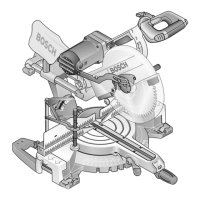
